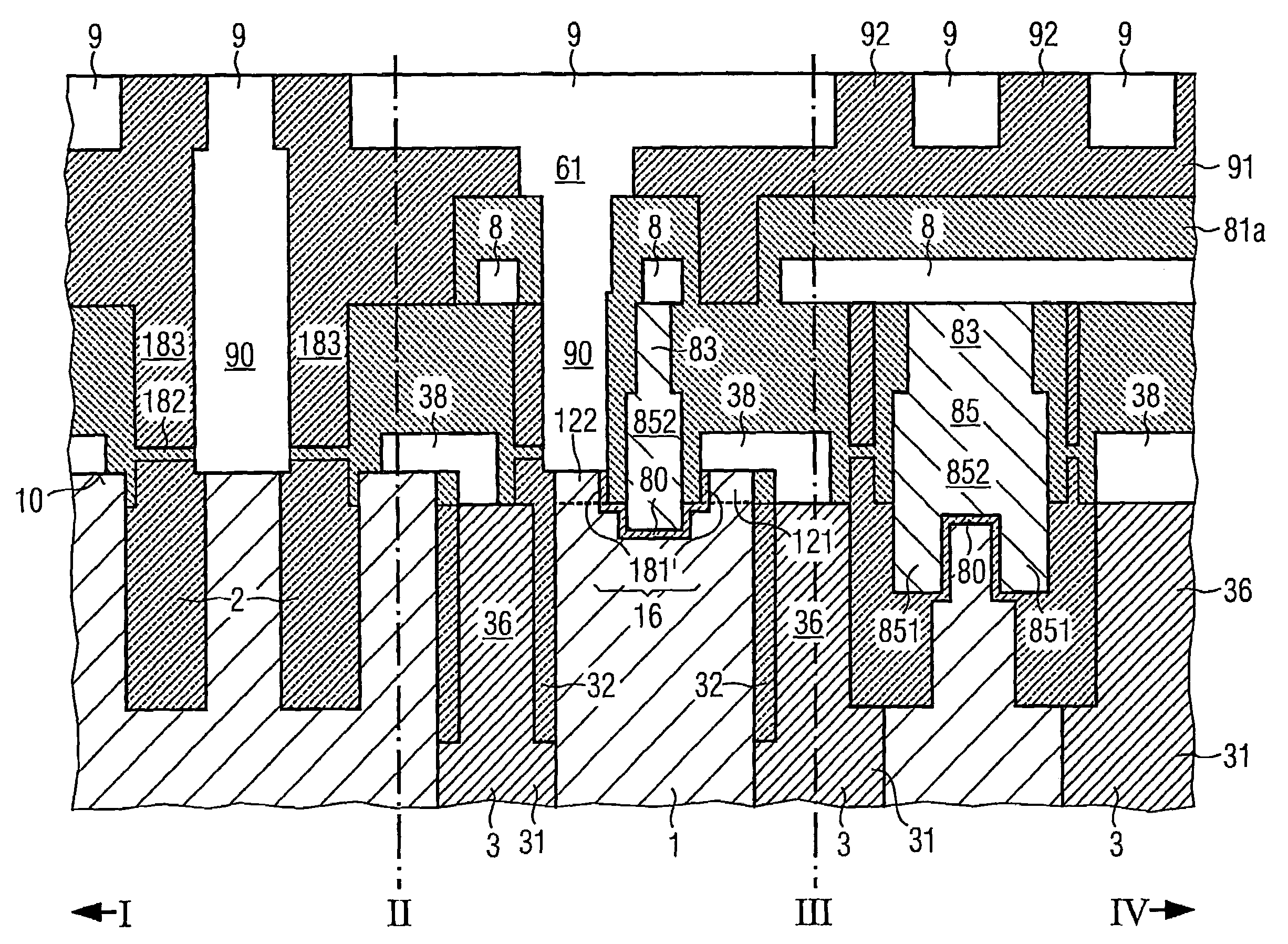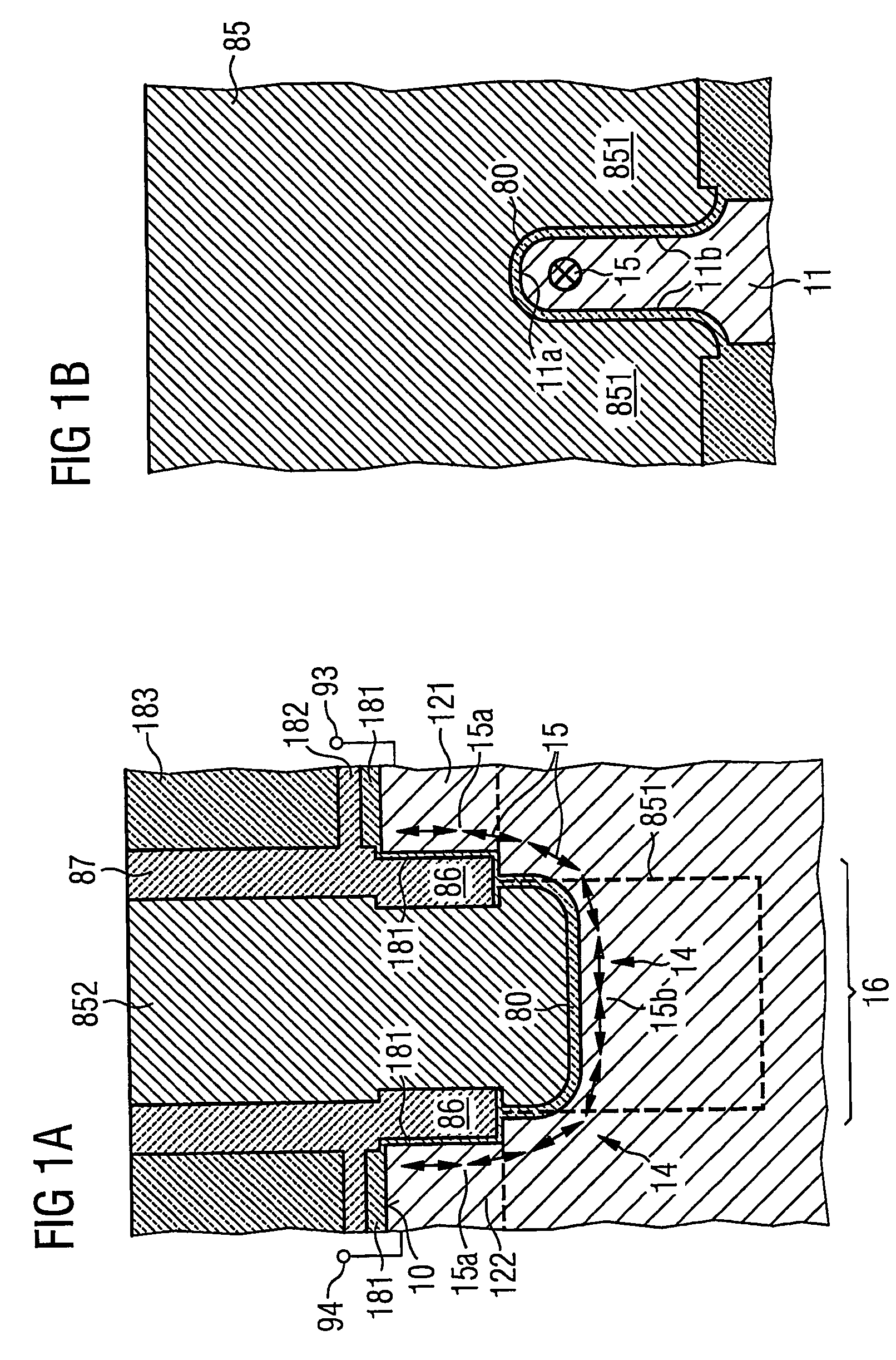Transistor, memory cell array and method of manufacturing a transistor
a memory cell array and transistor technology, applied in the field of transistors, can solve the problems of difficulty in providing a surface contact to a stack capacitor, difficulty in integrating a vertical transistor with a stack capacitor, and insufficient isolation properties of access transistors in non-addressed states, so as to achieve the effect of reducing contact resistance, maintaining source/drain region width, and reducing the influence of passing wordlines on adjacent active areas
- Summary
- Abstract
- Description
- Claims
- Application Information
AI Technical Summary
Benefits of technology
Problems solved by technology
Method used
Image
Examples
first embodiment
[0054]FIGS. 2A to 2W illustrate the present invention, in which a memory cell array including a transistor of the present invention and a trench capacitor are implemented.
[0055]FIG. 2A illustrates a plan view on the memory cell array, including a plurality of memory cells 100, each memory cell including a trench capacitor 3 and a transistor 16. A plurality of word lines 8 is arranged in a first direction, and a plurality of bit lines is arranged perpendicularly to the word lines 8. Also illustrated in FIG. 2A are the sites I, II, III and IV, which illustrate the directions along which the cross-sectional views illustrated in FIG. 2B, for example, are taken.
[0056]More specifically, the cross-sectional view from I to II illustrates a cross-section perpendicular to a bit line between two adjacent word lines 8, whereas the cross-sectional view from II to III illustrates a cross-section perpendicular to the word lines along a bit line 9, and the cross-sectional view from III to IV illust...
second embodiment
[0093]FIGS. 3A to 3L illustrate the present invention, in which a memory cell includes a stacked capacitor and the transistor which is described above with reference to FIGS. 1A and 1B.
[0094]FIG. 3A illustrates a layout of the active areas 12 of the memory cell array. As illustrated in FIG. 3A two active areas 12 in which the transistor is to be formed are disposed adjacent to each other, and they share a common bit line contact 90 which is indicated by broken lines. The stacked capacitors 4 belonging to each of the memory cells 100 are also indicated by broken lines 4. The segments of the active areas 12 are separated from each other by isolation trenches 23.
[0095]The sectional views illustrated in FIGS. 3B, 3C, 3F, 3G, and 3J are taken between the points V and V.
[0096]For providing the memory cell array according to the second embodiment of the present invention, first, isolation trenches 23 are photolithographically defined and etched in the surface 10 of a semiconductor substrat...
third embodiment
[0118]For implementing the present invention, first, a pad oxide layer (not illustrated) and a silicon nitride layer 17 are deposited on the surface 10 of a semiconductor substrate 1, in particular, a silicon substrate 1. Thereafter, the active areas 12 of the memory cell are photolithograghically defined by known methods and isolation trenches 23 are etched in a common manner so as to expose the active areas 12. The sidewalls of the active areas are oxidized, and the isolation trenches 23 are filled with an insulating material, in particular, a silicon dioxide layer. The resulting surface is planarized. The resulting structure is illustrated in the lower part of FIG. 4A, whereas the upper part of FIG. 4A illustrates a plan view on the array. As can be gathered from the upper part of FIG. 4A, the line connecting VI and VII intersects the active area 12, whereas the line connecting VII and VIII intersects the isolation trenches 23 as well as the active area 12 at the smaller side the...
PUM
 Login to View More
Login to View More Abstract
Description
Claims
Application Information
 Login to View More
Login to View More - R&D
- Intellectual Property
- Life Sciences
- Materials
- Tech Scout
- Unparalleled Data Quality
- Higher Quality Content
- 60% Fewer Hallucinations
Browse by: Latest US Patents, China's latest patents, Technical Efficacy Thesaurus, Application Domain, Technology Topic, Popular Technical Reports.
© 2025 PatSnap. All rights reserved.Legal|Privacy policy|Modern Slavery Act Transparency Statement|Sitemap|About US| Contact US: help@patsnap.com



